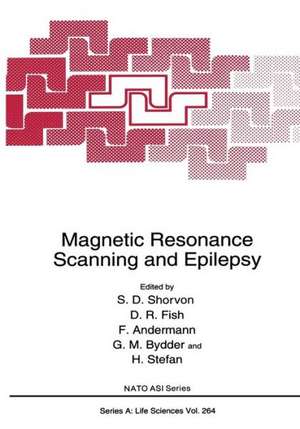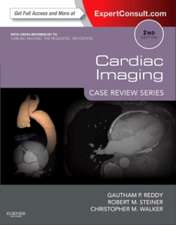Magnetic Resonance Scanning and Epilepsy: NATO Science Series A:, cartea 264
Editat de Simon D. Shorvon, D. R. Fish, F. Andermann, G.M. Bydder, H. Stefanen Limba Engleză Paperback – 23 oct 2012
Din seria NATO Science Series A:
- 15%
 Preț: 656.58 lei
Preț: 656.58 lei - 15%
 Preț: 655.13 lei
Preț: 655.13 lei - 15%
 Preț: 678.35 lei
Preț: 678.35 lei -
 Preț: 397.38 lei
Preț: 397.38 lei - 5%
 Preț: 377.87 lei
Preț: 377.87 lei -
 Preț: 397.76 lei
Preț: 397.76 lei - 18%
 Preț: 1232.41 lei
Preț: 1232.41 lei - 5%
 Preț: 731.64 lei
Preț: 731.64 lei -
 Preț: 413.15 lei
Preț: 413.15 lei - 15%
 Preț: 649.22 lei
Preț: 649.22 lei - 5%
 Preț: 369.45 lei
Preț: 369.45 lei -
 Preț: 407.56 lei
Preț: 407.56 lei - 5%
 Preț: 2162.19 lei
Preț: 2162.19 lei -
 Preț: 407.39 lei
Preț: 407.39 lei -
 Preț: 396.40 lei
Preț: 396.40 lei - 15%
 Preț: 663.93 lei
Preț: 663.93 lei -
 Preț: 387.38 lei
Preț: 387.38 lei -
 Preț: 393.13 lei
Preț: 393.13 lei -
 Preț: 398.35 lei
Preț: 398.35 lei -
 Preț: 401.24 lei
Preț: 401.24 lei - 15%
 Preț: 678.81 lei
Preț: 678.81 lei -
 Preț: 395.09 lei
Preț: 395.09 lei - 18%
 Preț: 952.40 lei
Preț: 952.40 lei - 15%
 Preț: 654.43 lei
Preț: 654.43 lei -
 Preț: 402.00 lei
Preț: 402.00 lei -
 Preț: 401.24 lei
Preț: 401.24 lei - 15%
 Preț: 655.27 lei
Preț: 655.27 lei -
 Preț: 394.71 lei
Preț: 394.71 lei -
 Preț: 384.48 lei
Preț: 384.48 lei - 5%
 Preț: 395.61 lei
Preț: 395.61 lei - 5%
 Preț: 1421.57 lei
Preț: 1421.57 lei - 15%
 Preț: 651.34 lei
Preț: 651.34 lei -
 Preț: 400.10 lei
Preț: 400.10 lei -
 Preț: 386.99 lei
Preț: 386.99 lei - 5%
 Preț: 386.11 lei
Preț: 386.11 lei -
 Preț: 403.91 lei
Preț: 403.91 lei - 15%
 Preț: 651.51 lei
Preț: 651.51 lei -
 Preț: 393.90 lei
Preț: 393.90 lei - 5%
 Preț: 376.43 lei
Preț: 376.43 lei -
 Preț: 400.26 lei
Preț: 400.26 lei - 5%
 Preț: 388.84 lei
Preț: 388.84 lei -
 Preț: 400.65 lei
Preț: 400.65 lei - 5%
 Preț: 740.58 lei
Preț: 740.58 lei - 18%
 Preț: 1225.16 lei
Preț: 1225.16 lei - 5%
 Preț: 386.46 lei
Preț: 386.46 lei -
 Preț: 421.82 lei
Preț: 421.82 lei
Preț: 375.49 lei
Preț vechi: 395.25 lei
-5% Nou
Puncte Express: 563
Preț estimativ în valută:
71.85€ • 76.83$ • 59.91£
71.85€ • 76.83$ • 59.91£
Carte tipărită la comandă
Livrare economică 17 aprilie-01 mai
Preluare comenzi: 021 569.72.76
Specificații
ISBN-13: 9781461360865
ISBN-10: 1461360862
Pagini: 336
Ilustrații: X, 323 p.
Dimensiuni: 178 x 254 x 18 mm
Greutate: 0.59 kg
Ediția:Softcover reprint of the original 1st ed. 1994
Editura: Springer Us
Colecția Springer
Seria NATO Science Series A:
Locul publicării:New York, NY, United States
ISBN-10: 1461360862
Pagini: 336
Ilustrații: X, 323 p.
Dimensiuni: 178 x 254 x 18 mm
Greutate: 0.59 kg
Ediția:Softcover reprint of the original 1st ed. 1994
Editura: Springer Us
Colecția Springer
Seria NATO Science Series A:
Locul publicării:New York, NY, United States
Public țintă
ResearchCuprins
1. Magnetic Resonance Imaging in Epilepsy: The Central Clinical Research Questions.- 2. The Anatomical Bases of the Epilepsies and MRI: Implications for MRI.- 3. Brain Structure in Epilepsy: The Crucial Role of MRI.- 4. MR Spectroscopy in Epilepsy.- 5. Mesial Temporal Lobe Structures: Anatomy.- 6. Magnetic Resonance Imaging of Hippocampal Sclerosis: Reliability of Visual Diagnosis and Implications for Surgical Treatment.- 7. Volumetric MRI Studies of the Hippocampus.- 8. Advances in Morphometric and Volumetric Analysis in Temporal Lobe Epilepsy.- 9. The Role of MRI Volumetric Studies in the Investigation of Patients with Intractable Epilepsy.- 10. The Future Role for MR Imaging in Epilepsy: Morphometry and Volume Analysis.- 11. Quantitative Relaxometry of Hippocampal Sclerosis.- 12. The Significance of T2 Changes in the Hippocampus.- 13. Investigation of Effects of Vigabatrin with Magnetic Resonance Imaging and Spectroscopy In Vivo.- 14. MR of Epilepsy: Three Observations.- 15. Cortical Dysplasia and Heterotopias.- 16. Cortical Dysgenesis in Adults with Epilepsy.- 17. Hemimegalencephaly.- 18. Agenesis of the Corpus Callosum.- 19. The Congenital Bilateral Peri-sylvian Syndrome: Imaging Findings.- 20. Focal Cortical Dysplasia in Temporal Lobe Epilepsy: The Role of Magnetic Resonance Imaging.- 21. MR in Congenital and Hereditary Metabolic Disorders Associated with Epilepsy.- 22. MRI in the Delineation of Genetic Metabolic Disorders.- 23. Minimal Developmental Disturbances in Epilepsy and MRI.- 24. Correlation of MRI and EEG.- 25. Principles of Stereotaxy Applied to MRI and EEG.- 26. MRI Stereotactic Placement of Intracranial Electrodes.- 27. Frameless Stereotaxy: Technical Aspects.- 28. Correlation of MRI and MEG.- 29. Volumetric Magnetic Resonance Imaging: Impact on Neuropsychological Studies.- 30. MRI and Intellectual Decline in Epilepsy.- 31. MRI and SPECT in Epilepsy Surgery.- 32. MR-Directed Stereotactic Resections and Per-operative Screening Using Low-Field MRI.- 33. Non-malignant Tumoural Lesions:.- 34. Vascular Anomalies in Epilepsy: MRI Contribution.- 35. Magnetic Resonance and Neocortical Epilepsy Atrophies.- 36. Application of Spectroscopy to Epilepsy.- 37. Proton MR Spectroscopic Imaging in the Investigation of Patients with Temporal Lobe Epilepsy.- 38. Proton MR Spectroscopy in the Evaluation of Mesial Temporal Sclerosis.- 39. The Potential of Proton MR Spectroscopy for Monitoring: Pathological Alterations of Human Cerebral Metabolism In Vivo.- 40. Quantitative Proton MR Spectroscopy of the Human Brain.- 41. Image-Guided Proton MR Spectroscopy in Epilepsy.- 42. Techniques for Localisation and Signal Improvement in In Vivo Proton and Phosphorus MR Spectroscopy.- 43. Proton Observation of 13C-Labelled Metabolites.- 44. Use of Combined 13C -, 19F - and 31P-MR Spectroscopy in Research on Brain Metabolism.- 45. Malignant Tumoural Lesions Investigated by MRS.- 46. Analysis of Cortical Patterns.- 47. Digital Image Processing for Epilepsy.- 48. An MRI-Based Probabilistic Atlas of Neuroanatomy.- 49. Other Methods: Functional Imaging, Magnetisation Transfer, and Relaxation Times.- 50. MR Imaging of Diffusion.- 51. Fast Imaging and Serial Scanning.- 52. NMR Studies of Brain Activation.- 53. Differential Diagnosis of Human Intracranial Tumors In Vivo Using 1H MR Spectroscopic Imaging and Feature Space for Spectral Pattern Recognition.




